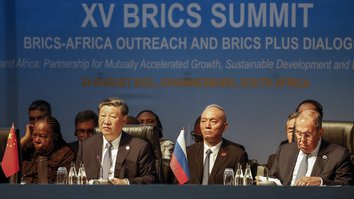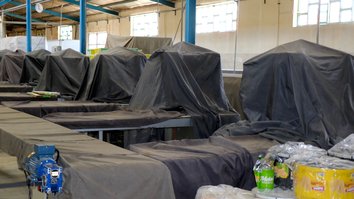Iran's Islamic Revolutionary Guard Corps (IRGC) last week unveiled a new strategic missile base during an unusual closed door ceremony, the latest in a string of moves by the regime that threaten world commerce passing through the Strait of Hormuz.
Even though regime reporters typically attend such unveilings, the IRGC denied the press and public access to this ceremony, making it impossible to verify if this was a new or existing base.
The base, reportedly situated somewhere in the Gulf, houses "one of multiple sets of storage equipment for the IRGC Navy's strategic missiles", Sepah News, the IRGC's media outlet, quoted IRGC Commander Hossein Salami as saying on January 8.
"There are multiple [storage] compounds similar to this one within the IRGC Navy," Salami added. "You can see an entire row of missiles along with their launching systems. The row goes on for kilometres."
![Members of the IRGC standing next to trucks apparently filled with missiles inside a new naval base near the Gulf. [IRGC]](/cnmi_pf/images/2021/01/13/27934-missilebase-585_329.jpg)
Members of the IRGC standing next to trucks apparently filled with missiles inside a new naval base near the Gulf. [IRGC]
"These missiles are precision guided and accurate, with ranges of hundreds of kilometres. They are highly destructive and can pass through the enemy's electronic [defences]," he said.
The IRGC, however, has a long history of boasting about its weaponry, and a track record of deficient missile and radar systems, many dilapidated or, if new, assembled with sub-par Russian or Chinese material.
The tragic January 8, 2020, incident in which the IRGC accidentally shot down a Ukraine-bound passenger jet shortly after it took off from Tehran is only the latest in a string of high-profile errors.
These errors date back to at least 2011, when several top IRGC personnel died in an explosion linked to Iran's missile development programme.
Revenge rhetoric
Since early December, the Iranian regime issued a stream of threats, calling to avenge the assassinations of nuclear mastermind Mohsen Fakhrizadeh and IRGC Quds Force commander Qassem Soleimani.
IRGC intelligence came under fire after Fakhrizadeh's assassination. His death, added to the killings of several other Iranian nuclear scientists in recent years, several explosions in sensitive military bases, and the theft of sensitive nuclear and missile programme documents from a nuclear facility in Iran, has prompted a deluge of criticism of Iran's intelligence capabilities.
Isolated and on the brink of economic collapse due to rampant corruption, gross mismanagement and biting US sanctions, the Iranian regime is grappling with the threat of civil uprising amid severe stagnation and hyperinflation.
The government's income has plummeted from obstacles to its sale of oil.
Meanwhile, Iran has started the process to enrich uranium to 20% purity at its underground Fordow facility, state media reported January 4, going well beyond the threshold set by the 2015 nuclear deal.
It is the latest and most important suspension of nuclear commitments by Iran under the landmark deal.
Iran is progressing "quite rapidly" in enrichment activities and is expected to reach monthly production of 10kg of 20% enriched uranium at its Fordow facility, Rafael Grossi, director-general of the International Atomic Energy Agency (IAEA), said Monday (January 11).
Recent US sorties over Gulf waters and the deployment of additional materiel, most recently the January 7 flyover of B-52 bombers, come within the framework of preparing for any potential offensive action by Iran or its militia groups.

![IRGC commanders walk along an underground corridor inside a new naval missile base on January 9. [IRGC]](/cnmi_pf/images/2021/01/13/27933-irgcbase-585_329.jpg)






